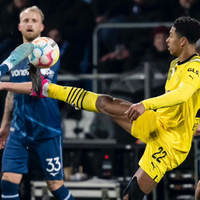Real Madrid vs Atlético de Madrid: A Century-Old Rivalry Renewed
Por um escritor misterioso
publicado em novembro/05/2024
:quality(80)/cloudfront-us-east-1.images.arcpublishing.com/estadao/7CROP5CIJZEMFHH4DYAAGI4EIU.jpg)
The intense rivalry between Real Madrid and Atlético de Madrid has captivated football fans for over a century. From thrilling encounters to historic battles, this article dives into the significance of this fierce rivalry and explores some of the key moments that have defined it.

The origins of this intense rivalry can be traced back to the early 20th century when both clubs were founded within just years of each other. Real Madrid was established in 1902 as 'Madrid Football Club,' while Atlético de Madrid emerged in 1903 under the name 'Athletic Club Sucursal de Madrid.' Their close proximity geographically meant they were bound to cross paths frequently on their journeys to success.
One defining period in this rivalry came during the Spanish Civil War. As tensions escalated across Spain, divided loyalties surfaced among football clubs. While most teams aligned themselves with either nationalists or republicans, Real Madrid became associated with General Franco's regime and subsequently enjoyed considerable support from that faction. On the other hand, Atlético de Madrid embraced its working-class roots and garnered support from those opposed to Franco's rule.
As both clubs experienced success on different fronts during those turbulent times, their contrasting ideologies added an extra layer of intensity when they faced off on the pitch. Matches symbolized more than just sporting competition—it was a battle for representation and ideological supremacy.
In recent years, their rivalry has been reignited by numerous high-stakes encounters in domestic leagues like La Liga and Copa del Rey, as well as in European competitions such as the UEFA Champions League. These matchups have produced remarkable stories that have captured the imagination of football fans worldwide.
One such story unfolded during the UEFA Champions League Final in 2014. Real Madrid and Atlético de Madrid found themselves pitted against each other in a classic city derby for European glory. The match ended 1-1 after regular time, with Atlético de Madrid just minutes away from victory. However, Real Madrid mounted a dramatic comeback during extra time, securing a 4-1 win and their tenth European title. It was a heart-wrenching defeat for Atlético de Madrid but showcased both teams' determination and resilience.
The rivalry between these two iconic clubs extends beyond individual matches; it has also involved heated battles for supremacy within Spanish football leagues. Over the years, they have gone toe-to-toe to claim league titles, creating captivating narratives filled with intense competition and unforgettable moments.
Real Madrid's success on the international stage has often been contrasted with Atlético de Madrid's dominance in domestic competitions. This dynamic has led to intriguing power dynamics that heighten the stakes whenever these two sides meet.
In conclusion, the rivalry between Real Madrid and Atlético de Madrid is one of fierce competition, deep-seated history, and conflicting ideologies. It encapsulates everything that makes football captivating—dazzling skills, thrilling comebacks, and compelling narratives steeped in passion





Palpite: Fenerbahce x Galatasaray – Campeonato Turco – 24/12/2023 - Lance!
For football enthusiasts around the world, few rivalries resonate as deeply as the one between Real Madrid and Atlético de Madrid. This clash between two of Spain's biggest football clubs transcends regional pride; it is a competition steeped in history, passion, and glorious moments.The origins of this intense rivalry can be traced back to the early 20th century when both clubs were founded within just years of each other. Real Madrid was established in 1902 as 'Madrid Football Club,' while Atlético de Madrid emerged in 1903 under the name 'Athletic Club Sucursal de Madrid.' Their close proximity geographically meant they were bound to cross paths frequently on their journeys to success.
One defining period in this rivalry came during the Spanish Civil War. As tensions escalated across Spain, divided loyalties surfaced among football clubs. While most teams aligned themselves with either nationalists or republicans, Real Madrid became associated with General Franco's regime and subsequently enjoyed considerable support from that faction. On the other hand, Atlético de Madrid embraced its working-class roots and garnered support from those opposed to Franco's rule.
As both clubs experienced success on different fronts during those turbulent times, their contrasting ideologies added an extra layer of intensity when they faced off on the pitch. Matches symbolized more than just sporting competition—it was a battle for representation and ideological supremacy.
In recent years, their rivalry has been reignited by numerous high-stakes encounters in domestic leagues like La Liga and Copa del Rey, as well as in European competitions such as the UEFA Champions League. These matchups have produced remarkable stories that have captured the imagination of football fans worldwide.
One such story unfolded during the UEFA Champions League Final in 2014. Real Madrid and Atlético de Madrid found themselves pitted against each other in a classic city derby for European glory. The match ended 1-1 after regular time, with Atlético de Madrid just minutes away from victory. However, Real Madrid mounted a dramatic comeback during extra time, securing a 4-1 win and their tenth European title. It was a heart-wrenching defeat for Atlético de Madrid but showcased both teams' determination and resilience.
The rivalry between these two iconic clubs extends beyond individual matches; it has also involved heated battles for supremacy within Spanish football leagues. Over the years, they have gone toe-to-toe to claim league titles, creating captivating narratives filled with intense competition and unforgettable moments.
Real Madrid's success on the international stage has often been contrasted with Atlético de Madrid's dominance in domestic competitions. This dynamic has led to intriguing power dynamics that heighten the stakes whenever these two sides meet.
In conclusion, the rivalry between Real Madrid and Atlético de Madrid is one of fierce competition, deep-seated history, and conflicting ideologies. It encapsulates everything that makes football captivating—dazzling skills, thrilling comebacks, and compelling narratives steeped in passion

100 fachadas de casas modernas e incríveis para inspirar seu projeto Fachadas de casas pequenas, Fachadas de casas modernas, Fachadas de casas

Napoli x Lazio: onde assistir ao vivo e o horário do jogo hoje (03/03) pelo Campeonato Italiano, Futebol

Real Madrid x Rayo Vallecano – onde assistir ao vivo, horário e escalações – La Liga
